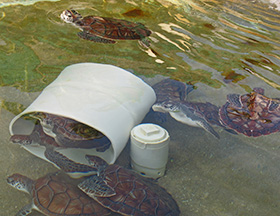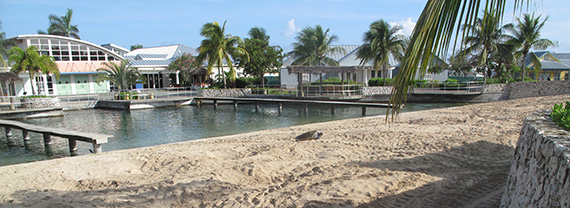Linking the UW and Caribbean Sea Turtle Research
By Dr. Walter Mustin, Chief Research Officer, Cayman Turtle Conservation and Education Center
 One-year-old green sea turtles finding refuge and shade; “chilling out,” as they say here in the Caribbean.
One-year-old green sea turtles finding refuge and shade; “chilling out,” as they say here in the Caribbean.
Aquaculture and mariculture became the focus of intense interest to me in my senior year at UW (class of 1975) after attending a series of guest lectures at the School of Fisheries delivered by Dr. Ling of what is now the Peoples Republic of China. Dr. Ling was the first researcher to “close the loop” by completing the life cycle of the giant freshwater shrimp Macrobrachium rosenbergii in captivity. This feat was not unlike UW’s Dr. Donaldson’s early work with steelhead trout, where fry released from eggs hatched on the UW campus eventually returned to the campus as adults, having made a remarkable journey from Lake Union to the Alaska peninsula and back to Lake Union. My experiences at UW impressed upon me how effective well-managed fisheries and aquaculture were in affecting sustainable harvest of dwindling populations of fish, and for providing high-quality protein for human consumption. This UW-seeded interest landed me my first aquaculture job as a Fishery Extension Agent for the Thai Government, 60 miles from the Mekong River in Thailand, in my capacity as a Peace Corps volunteer. The husbandry techniques and biological considerations related to salmonids that I had learned while at UW had direct application in northeast Thailand, 7,300 miles away. The tilapia, cyprinids, and polyculture projects that we promoted to rural farmers involved many of the same biological and harvest issues facing salmon and trout in Washington State. It was there that I quickly came to appreciate the basic science skills that I had acquired during my higher education.
Currently as Chief Research Officer at the Cayman Turtle Conservation and Education Center (CTCEC) Grand Cayman Island, I am faced with sea turtle husbandry challenges that regularly require/involve “applied research” using the scientific method and evidence-based science. Fortunately, my undergraduate courses at the UW's School of Fisheries helped provide me with a solid science foundation for this type of work.
 A female green sea turtle breeder working her 300-lb body up on the Turtle Centre’s artificial beach. Females like her will lay up to 10 clutches of 100 eggs each during the nesting season. Nesting occurs during the evenings from May to September. Eggs are removed from the beach and incubated in a purpose-built hatchery. Over thirty thousand eggs were collected from this beach last season. Photos: Walter Mustin.
A female green sea turtle breeder working her 300-lb body up on the Turtle Centre’s artificial beach. Females like her will lay up to 10 clutches of 100 eggs each during the nesting season. Nesting occurs during the evenings from May to September. Eggs are removed from the beach and incubated in a purpose-built hatchery. Over thirty thousand eggs were collected from this beach last season. Photos: Walter Mustin.
The CTCEC is a captive breeding facility and home to roughly 8,000 green sea turtles. The genetic, nutrition, hatchery, health, and herd management issues affecting salmonids are examples of the types of exposure that UW gave me as an undergraduate that have also helped me here.
To any of you readers planning to visit the Cayman Islands, you are welcome to visit me here at the CTCEC for further information.



